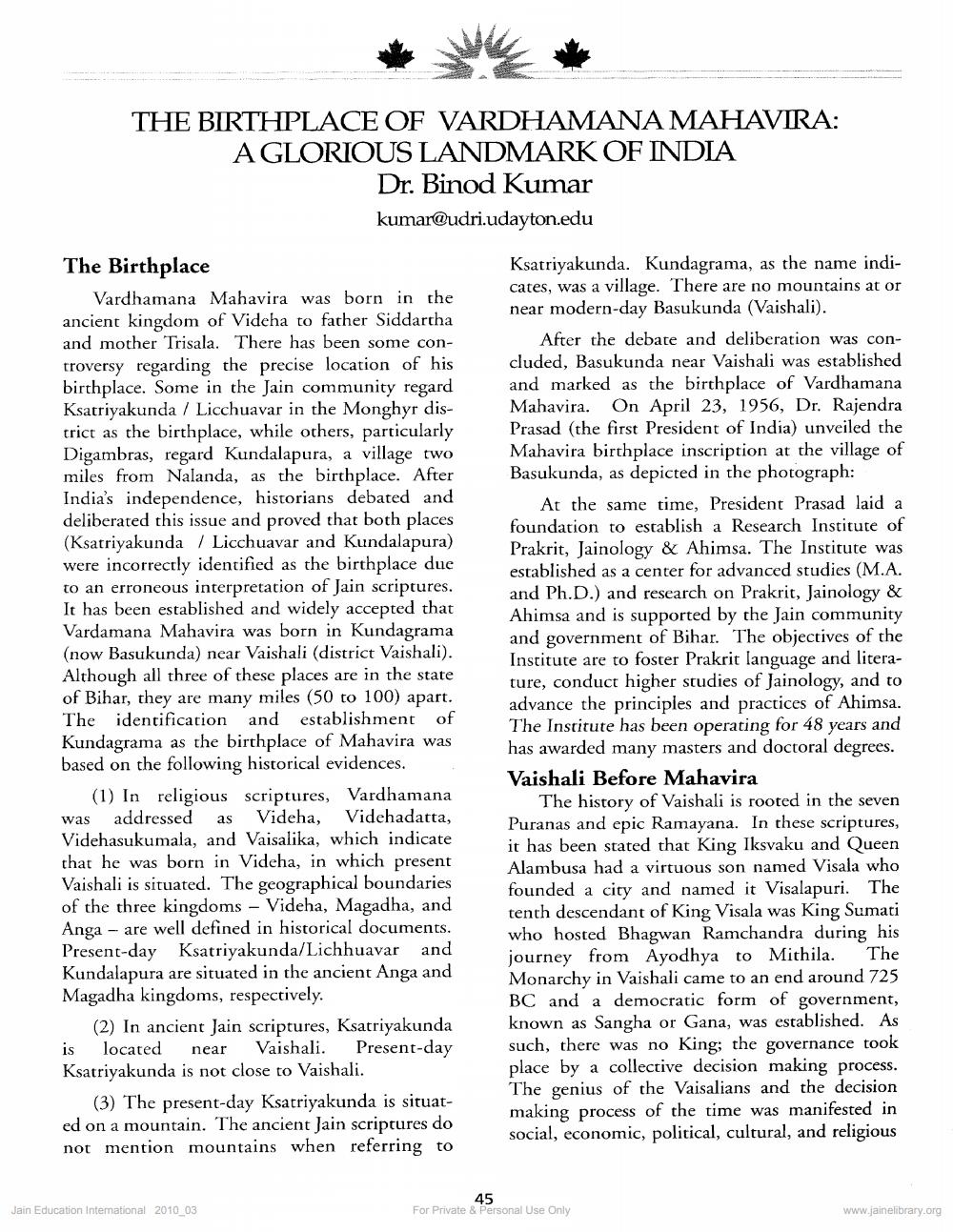________________
THE BIRTHPLACE OF VARDHAMANA MAHAVIRA: A GLORIOUS LANDMARK OF INDIA
Dr. Binod Kumar
[email protected]
The Birthplace
Vardhamana Mahavira was born in the ancient kingdom of Videha to father Siddartha and mother Trisala. There has been some controversy regarding the precise location of his birthplace. Some in the Jain community regard Ksatriyakunda / Licchuavar in the Monghyr district as the birthplace, while others, particularly Digambras, regard Kundalapura, a village two miles from Nalanda, as the birthplace. After India's independence, historians debated and deliberated this issue and proved that both places (Ksatriyakunda / Licchuavar and Kundalapura) were incorrectly identified as the birthplace due to an erroneous interpretation of Jain scriptures. It has been established and widely accepted that Vardamana Mahavira was born in Kundagrama (now Basukunda) near Vaishali (district Vaishali). Although all three of these places are in the state of Bihar, they are many miles (50 to 100) apart. The identification and establishment of Kundagrama as the birthplace of Mahavira was based on the following historical evidences.
(1) In religious scriptures, Vardhamana was addressed as Videha, Videhadatta, Videhasukumala, and Vaisalika, which indicate that he was born in Videha, in which present Vaishali is situated. The geographical boundaries of the three kingdoms - Videha, Magadha, and Anga - are well defined in historical documents. Present-day Ksatriyakunda/Lichhuavar and Kundalapura are situated in the ancient Anga and Magadha kingdoms, respectively.
(2) In ancient Jain scriptures, Ksatriyakunda is located near Vaishali. Present-day Ksatriyakunda is not close to Vaishali.
(3) The present-day Ksatriyakunda is situated on a mountain. The ancient Jain scriptures do not mention mountains when referring to
Ksatriyakunda. Kundagrama, as the name indicates, was a village. There are no mountains at or near modern-day Basukunda (Vaishali).
After the debate and deliberation was concluded, Basukunda near Vaishali was established and marked as the birthplace of Vardhamana Mahavira. On April 23, 1956, Dr. Rajendra Prasad (the first President of India) unveiled the Mahavira birthplace inscription at the village of Basukunda, as depicted in the photograph:
At the same time, President Prasad laid a foundation to establish a Research Institute of Prakrit, Jainology & Ahimsa. The Institute was established as a center for advanced studies (M.A. and Ph.D.) and research on Prakrit, Jainology & Ahimsa and is supported by the Jain community and government of Bihar. The objectives of the Institute are to foster Prakrit language and literature, conduct higher studies of Jainology, and to advance the principles and practices of Ahimsa. The Institute has been operating for 48 years and has awarded many masters and doctoral degrees. Vaishali Before Mahavira
The history of Vaishali is rooted in the seven Puranas and epic Ramayana. In these scriptures, it has been stated that King Iksvaku and Queen Alambusa had a virtuous son named Visala who founded a city and named it Visalapuri. The tenth descendant of King Visala was King Sumati who hosted Bhagwan Ramchandra during his journey from Ayodhya to Mithila. The Monarchy in Vaishali came to an end around 725 BC and a democratic form of government, known as Sangha or Gana, was established. As such, there was no King; the governance took place by a collective decision making process. The genius of the Vaisalians and the decision making process of the time was manifested in social, economic, political, cultural, and religious
Tail.
Jain Education Interational 2010_03
45 For Private & Personal Use Only
www.jainelibrary.org




